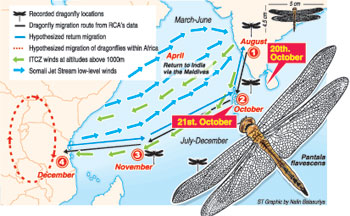Last week, a large cloud of dragonflies was observed along the west coast near Colombo. Subsequently, an increase of dragonflies was sighted in many areas islandwide. This sudden appearance of dragonflies in large numbers raised the curiosity of the public.
This wave of dragonflies was first reported moving southwards in large numbers on October 20 morning. One of the witnesses, Nashath Haffi of the Field Ornithology Group of Sri Lanka (FOGSL) says while travelling by train he observed this wave around 7 a.m., parallel to the coast, continuously from Moratuwa to Kollupitiya. It is not clear whether the swarm continued further southward.
With the aim of investigating the phenomena, the Sunday Times visited the Dehiwala beach, which was in the middle of the recorded route of the dragonflies last Sunday. The residents, mostly fisher folk, when interviewed, confirmed sighting on October 20 a wave of dragonflies flying southwards at a height of about 10 feet. Some of them said it was the first time they had observed such a phenomenon, while others said it was an annual event.
The Dehiwala residents also assisted in catching a few dragonflies still hovering in the vicinity. This dragonfly is about 4.5 cm long, with a wingspan of about 5 cm. The body is a golden colour (dark yellow) with a dark line. The wings are clear and very broad at the base, with a tip near the end. The photos were shared with dragonfly experts and the species identified as Globe Skimmer, or Wandering Glider, scientifically categorised as Pantala flavescens.
Investigations also revealed an interesting fact that this dragonfly is migratory like birds. A Dragonfly migration is believed to be happening annually from India to Africa via the Maldives. Dr. Charles Anderson, who had researched this migration, confirms that, the dragonflies caught in Dehiwala, are the same species involved in the India-Africa migration. Living in the Maldives since 1983, Dr. Anderson continues to observe a sudden influx of dragonflies which raised his initial curiosity. Dragonflies need freshwater to raise their young, as their larvae stage is spent in freshwater.
However, the Maldives is a group of oceanic islands with sand that absorbs all the rainwater it gets. Hence, no freshwater pools are formed even after rain falls. So, apparently, the dragonflies recorded in the Maldives are from elsewhere.
Dr. Anderson started noting down dates of dragonflies seen for the first time in the Maldives, and then compared the data of dragonflies appearing in South India. He found a clear sequence of arrival dates from north to south. According to this data, dragonflies first arrive in Southern India and then in the Maldives. According to his research, each year, dragonflies first appear in the Maldive’s capital, Male, between October 4 and 23, with a mean arrival date of October 21. Quite interestingly, the sighting of the dragonfly wave along the west coast was reported on October 20, which is quite close to the dates they arrive in the Maldives. So, dragonflies seen in Sri Lanka, must also be those involved in this migration.
Dragonflies, though hardy, are small insects – so how can they fly such long distances? Dr. Anderson also attributes that wind patterns help them in this journey. In October, and continuing into November and December, a weather system called the Inter-Tropical Convergence Zone (ITCZ) moves southwards over the Maldives. Dr. Anderson suggests these dragonflies must be flying on these winds at altitudes above 1,000 metres.
“Ahead of the ITCZ, the wind blows towards India, but above and behind it, the winds blow from India. So, it seems that, the dragonflies are able to reach the Maldives by flying on these winds at altitudes above 1,000 metres” he said.
This could probably be assisting them to visit Sri Lanka too. Since last week, we are experiencing much rain, which could be a result of this weather pattern. Raising the importance of following traditional knowledge, many of the Dehiwala fishing community say these dragonfly waves appear with the change of wind, or ‘goda sulan’, which they are quite accustomed to identifying.
The researcher also found data of sudden appearances of dragonflies in Africa, and when collated, the analysis matches, indicating this migration continues all the way to Africa, more than 14,000 km away.
Migrant Watch - You too
can support science
There is a need for extensive research to solve the mysteries of this migration. But the first step would be to monitor where the dragonflies have been sighted in large numbers, which will at least give the coordinates of a possible map. The FOGSL has initiated a programme called MIGRANT WATCH, and invites the general public to forward information on these dragonfly movements. If you have seen swarms of dragonflies recently, please forward location and related dates.
Migrant Watch mainly aims at observing Migrant Birds as a Citizen Science project. Prof. Sarath Kotagama also highlights the importance of observation even by non-experts, as being immensely helpful, as that of the dragonfly migration, which was triggered by Nashath sharing his sighting on October 20. So, he invites all to participate in MIGRANT WATCH, and email the data to fogsl@slt.lk or, post it to FOGSL, Dept. of Zoology, University of Colombo, Colombo 3. Further details can be obtained from 2 501 332 / 0712 543 634.
|


